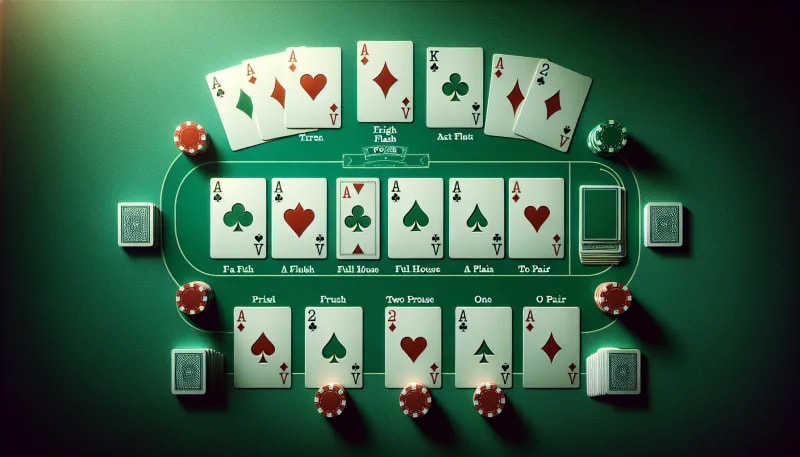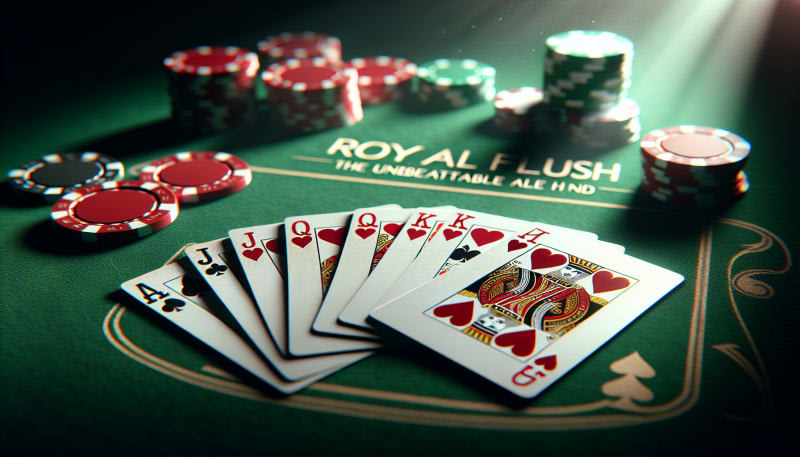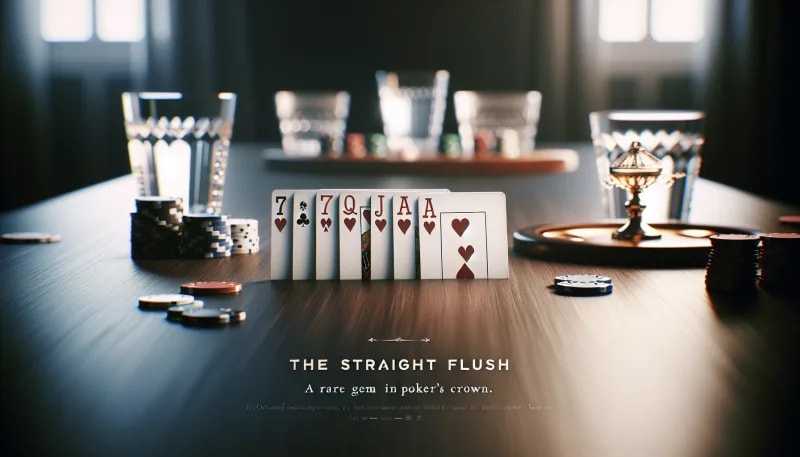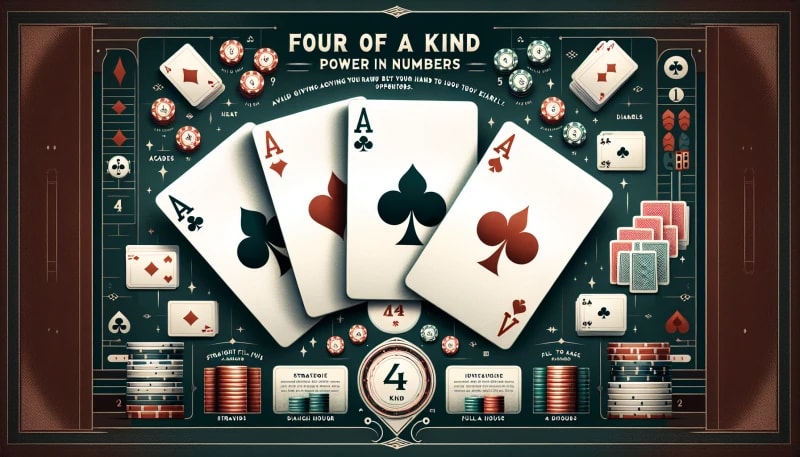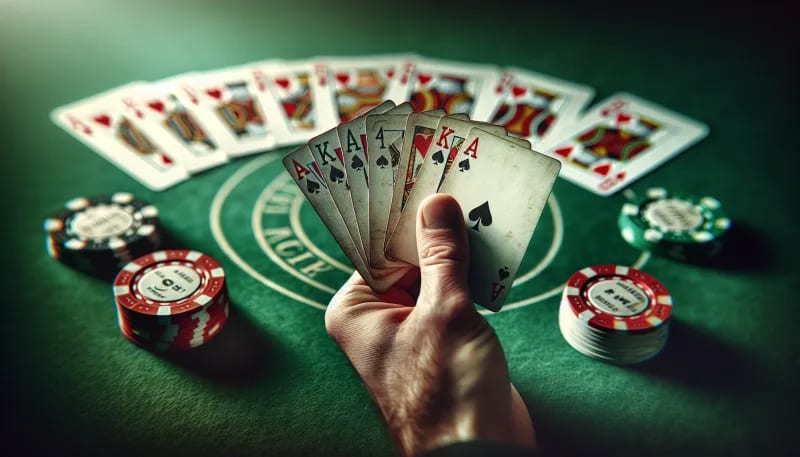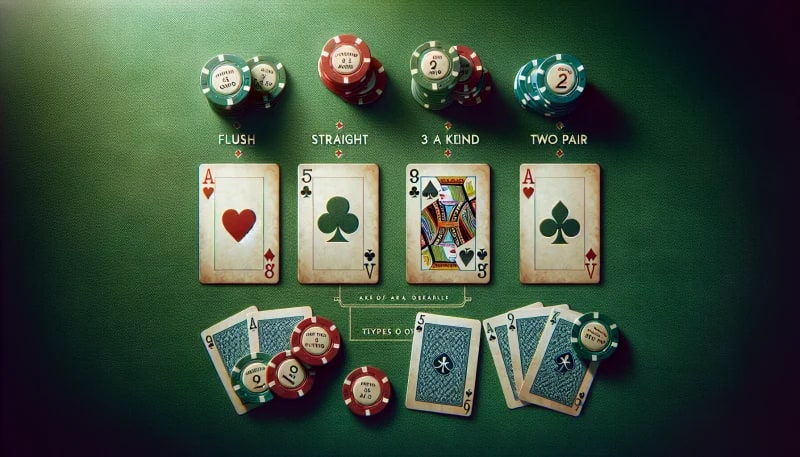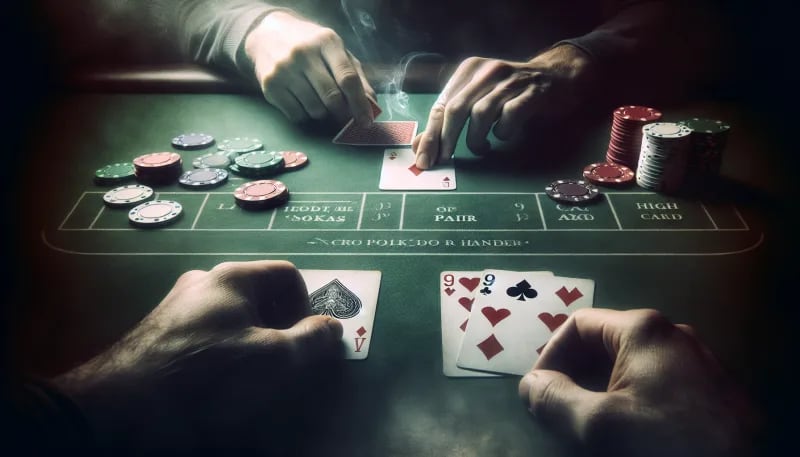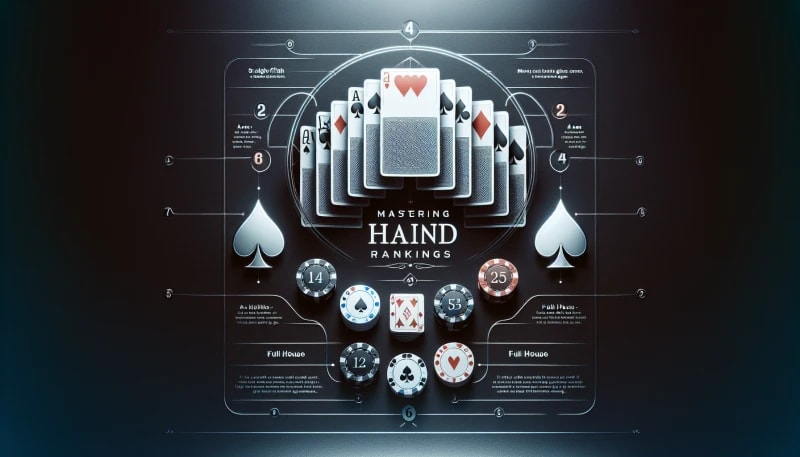Poker Hand Rankings: The Ultimate Guide to Understanding What Beats What
Introduction to Poker Hand Rankings
I'm glad you're here. Think of poker hand rankings as the ABCs of the game—you simply can't play effectively without knowing them. I mean, how would you know if you're holding gold or garbage, right? Understanding what beats what is crucial to making strategic decisions that could make or break your game.
Picture this: You're sitting at the table, the dealer's just dealt the cards, and your heart is racing. Will your hand lead you to victory? It all boils down to the strength of your hand against the rankings. Starting with Royal Flush at the top – the equivalent of hitting a grand slam in baseball – we'll work our way down to the humble High Card. But make no mistake, even a 'lowly' high card can be a winner in the right circumstances.
We're talking about a system where there are no ties or co-champions. Every poker hand falls within a clear hierarchy. Is your hand a full house? That's powerful, but is it enough to beat a four of a kind? (Spoiler alert: it isn't.)
Let's march through the battlefield of cards together, from the invincible Royal Flush all the way to the base camp, where our soldier High Card stands guard. The journey will be one of strategy, skill, and sometimes sheer luck. Are you ready to arm yourself with the knowledge that could crown you king at the felt table?
In the next section, we'll dive into the highest rank, worthy of a poker monarch: the Royal Flush. No hand can stand against it; it's the dream that keeps players coming back for more. But before we explore this poker utopia, remember that all hands have their place in the poker universe, and knowing where they stand is the first step to mastery.
Ready for the royal treatment? Let's go ahead and unveil the unbeatable hand.
Royal Flush: The Unbeatable Hand
Coming off the Introduction to Poker Hand Rankings, we've finally arrived at the summit of poker hands. Have you ever witnessed the ace high straight flush, also known as the Royal Flush? Yes, we're talking about the big kahuna, A-K-Q-J-10, all in the same suit. This hand isn’t just rare; it's the gold medalist, the dream that has players at the edge of their seats.
Why is it considered the pinnacle, you ask? Well, in the vast hierarchy of poker hands, nothing tops it – it's mathematically undefeated. In the realm of Texas Hold'em, catching a Royal Flush is a moment of sheer magic – roughly a 1 in 30,939 chance, according to the wizardry of statistics. Dive deeper into these odds here.
Imagine the scene. You're sitting there, cards in hand, and the dealer is drawing the final card to complete the board. Your heart pounds as the inevitable unfolds: a perfect, sequential suite blooms before your eyes. You just hit the royal jackpot. But what now? Do you unleash the beast immediately, or slow-play to extract maximum chips from your opponents?
Remember, the poker face must be your ally here. Showing any flicker of excitement might scare off opponents. Frequently, your main objective will be to keep them betting – to milk this once-in-a-lifetime cow for all it’s worth. Have you ever thought about going all-in? Sometimes, yes, but be astute; ensure there's enough in the pot to make your opponents stick around.
Transitioning to the Straight Flush: Almost at the Top, you'll see how this hand is the next best thing. But frankly, it’s akin to standing on the second-highest podium step–exhilarating, yet one step shy of legendary status. Your Royal Flush, however, wears the crown. Hands down, it's the monarch that leads with both power and rarity, a combination that keeps every poker player dreaming of the day they’ll say, "I had it, the unbeatable hand."
Straight Flush: Almost at the Top
Transitioning from the regality of the Royal Flush, I step down just one rung on the poker hand ladder to the Straight Flush. You get it, right? It's that feeling of elation when your heart races because you've just seen your hand is darn near unbeatable.
A Straight Flush is like the Royal's slightly less glamorous sibling. If the Royal is a king, think of the Straight Flush as the prince – still impressive, but not quite sitting on the throne. It's a sequential line-up of cards, all in the same suit, but not starting with a 10 and ending with an ace.
Let me break it down. If you're clutching a 7 through Jack of hearts—a Straight Flush—you're soaring high but the Royal, which is an ace-high Straight Flush, has a separate and loftier title for a reason. Isn't it a bit fascinating that simply by adding the top card of the deck, a Straight Flush evolves into royal status? Here's an interesting read on how it's all structured.
Within the realm of Straight Flushes, it's a battle of the titans where the highest card reigns supreme. Holding a queen-high Straight Flush makes you the master until someone reveals a king-high one. Then, respectfully, you bow down. It's a straightforward hierarchy—each Straight Flush is ranked based on its top card, the ace being a part of only the Royal.
Let's not forget, within the Straight Flush family, even the lowest member—a humble five-high—is a force to be reckoned with. This princely hand trumps other powerful combinations like a Full House or a Flush.
And now, a hint of what's next: imagine leaving the distinction of sequences and suits behind. Instead, think pure, raw power in repetition. That’s right, a tantalizing teaser for the dynamic "Four of a Kind: Power in Numbers". Ready to count your clones?
Four of a Kind: Power in Numbers
Riding high off that Straight Flush section? Hold on tight, because we're not stepping down in power. Instead, we’re diving into another powerhouse hand: Four of a Kind. It's that moment when the stars align and you find yourself staring at four cards, all of the same rank. The feeling? Priceless.
How does a glorious Four of a Kind form? It's simple, yet thrilling. Whether you're drawing to it or you hit it on the flop, when your hand includes four cards of the same value—let’s say, four kings—you're holding a force to be reckoned with. Odd are, you'll watch your opponents’ hopes fade as you reveal your cards.
But where does it stand in the ranking hierarchy? Only a Straight Flush and a Royal Flush can outshine this marvel. That means when you've got it, you're almost at the pinnacle of poker hand strength—only two steps away from absolute dominance.
Here comes the strategy, and let’s be bold about it: With Four of a Kind, subtlety is your ally. Why? Because you want to build the pot. I bet you do, don't you? The trick is not to scare off your competitors too quickly. Feed the action, make them commit, and when the time is ripe—strike.
What if the board is paired, or worse, showing the potential for a flush or straight? Fear not. Remember, your Four of a Kind is a juggernaut. However, keep an eye out for passive players suddenly turning aggressive—they might be holding a Straight Flush. That said, it’s a rare occurrence—lay your traps and ready yourself for a bountiful harvest.
So, before we move on to the tricky waters of the Full House, secure this knowledge. Four of a Kind is not just a hand; it’s a statement. Play it wisely, and the power of numbers will emphatically play in your favor. Want to delve deeper into strategy? Check out this link for a power-packed guide on how to maneuver this colossal hand: Four of a Kind Strategy Guide.
Full House: A Mixed Hand
Building on the sheer strength of a Four of a Kind, it's important not to overlook its slightly lesser cousin, the Full House. A Full House, one might wonder, what's that? Well, it's a hand that blends a Three of a Kind with a Pair, creating a five-card powerhouse. Imagine holding three jacks and a pair of sevens - that's a Full House.
Now, where does this put us in the standings? High, real high. The only hands that beat a Full House are Four of a Kind, Straight Flush, and Royal Flush. That's elite company, don't you think?
Let's dig a little deeper, though. Say we're head-to-head, and we both have Full Houses. Who takes the pot? It all comes down to the strength of the Three of a Kind. My three 8s beat your three 4s, regardless of our pairs. And if the unthinkable happens and we both have the same Three of a Kind, the pair decides the winner.
Ties can be heartbreakers, but they're rare. Charity cases in poker? I don't think so. Your hand must trump the other, or you're splitting the winnings. It's that simple.
Something else to keep in mind—a Full House is often referred to as a "full boat." Catchy, right? However, no matter what you call it, remember it's a mixed hand that demands respect. Get dealt a Full House, and you're steering a mighty ship, my friend. Keep your cool and bet wisely; overplay your hand, and you might just watch that boat sail without you.
As we move past the full boat, let's not forget what's downstream. The Flush, Straight, Three of a Kind, and Two Pair are still in the mix, forming the middle-tier hands that can make or break your game. Stay tuned as we dissect these pivotal combinations next. Can you hold steady when the waters get rough? Let's find out.
Flush, Straight, Three of a Kind, and Two Pair
Following the Full House, we find ourselves looking at the middle-tier hands of poker, each with its own strengths and weaknesses. A Flush—when you manage to collect five cards of the same suit, regardless of their numerical order—is a powerful hand. It even beats that deceptive Full House. But did you know that not all flushes are born equal? A King-high flush, for instance, will always lose to an Ace-high flush.
Let's talk Straights. These are five consecutive cards of any suit. They fall just beneath a Flush in the hand rankings. Sure, 7-8-9-10-J looks pretty, but will it hold up against a Flush? Not a chance. Still, against smaller fish in the pond like Three of a Kind or a Two Pair, it's a shark.
Speaking of Three of a Kind—three cards of the same rank—it’s easy to overvalue this hand, isn't it? It's solid, but let's not forget about those sneaky Straights and Flushes lurking in the depths. Exercise caution and know when to fold 'em if the board starts looking straight or flush-y.
Now, what about a Two Pair? We're talking two different pairs of cards plus a fifth card. This hand can be a real heartbreaker. You're sitting there, two pairs gleaming in your eyes, but then someone reveals their Straight. Tough break, friend.
Comparing these hands is crucial. Flush tops Straight, Straight beats Three of a Kind, and Three of a Kind ousts Two Pair. Remember that. What about tactical play, you ask? With a Flush or a Straight, you're often the predator, not the prey. But with Three of a Kind or Two Pair, you need to be more cautious, especially if there are potential Flush or Straight draws on the board. Ready to call or raise? Make sure Lady Luck isn't bluffing you.
Ever walked into a hand, tidy Two Pair in your pocket, only to walk out with pocket lint? It happens, but it's all about playing smart. And as we pass the baton to the showdown of a One Pair or the bleak landscape of a High Card, remember: poker's not just about the cards. It's about the strategy, the bravery, and sometimes, the art of the fold.
The One Pair and High Card
In the pecking order of poker hands, we've graduated from the might of a Flush and the straight line of a Straight to the humble beginning of a One Pair and the lone ranger, the High Card. What do you do when these are the cards dealt to you?
Let’s face it, when you're holding a One Pair, especially a low one, you're not exactly holding aces – pun intended. And if you're gripping a mere High Card, well, you're scrapping at the bottom of the totem pole. But that doesn't mean you’re out of the game. Not by a long shot.
Bluffing becomes your best friend when One Pair or High Card is all you've got up your sleeve. You've heard the saying: "If you can't spot the sucker in the first half-hour at the table, then you ARE the sucker." So, how do you avoid that? You make your opponents believe that sucker certainly isn’t you.
You've seen how two pairs can slice through tension like butter in the previous section. Use that knowledge. Forge your One Pair into something terrifying with a well-timed raise. It's a bold move. But poker is as much about the plays you make as the cards you hold.
However, tread cautiously – a failed bluff can cost you dearly. Know when to fold. It’s better to live to fight another day than to crash and burn on a weak hand. Mastering the art of folding is as crucial as the bluff. Fold with grace, and nobody can call you a fool.
With a High Card, you're dangling on a cliff's edge. But don't despair – sometimes the high card wins! It happens when the board plays, and nobody makes a hand better than yours. Alertness to the flow of the game is vital. Can you sense weakness? Can the table be taken with a deft play?
Ultimately, no hand is worthless. One Pair and High Card hands serve to humble us, to remind us that not every hand can be a royal flush. They are the test of our poker mettle, the foundation of our bluffing skills, and the cultivators of patience. Know that every hand has potential, but precise judgment and timing are key.
As we wrap our heads around the underdogs of poker hands, remember, the value of a hand changes with the context. It’s time to shift gears and apply these rankings in the wide array of poker variants. Next up, "Applying Hand Rankings in Different Poker Variants" – where we'll delve into how to utilize these principles across numerous styles of play.
Applying Hand Rankings in Different Poker Variants
We've already run through the classic power of a pair and the fallback of the high card, but let’s shuffle up and deal with how these rank across other poker variants. It’s all about context, right? When you jump from the ever-popular Texas Hold'em to games like Omaha or Seven-Card Stud, you'll notice the rules of engagement may seem familiar, but nuances can catch you off guard.
In Texas Hold'em, your strategic aim with hand rankings is clear. You need to form the best combination using those two hole cards along with the five community cards. With only two cards hidden, hand rankings stand out in their importance. But wait, does that mean hand values change when we switch the tables to Omaha?
Moving over to Omaha, here's the twist: you're dealt four hole cards and, crucial to note, must use exactly two from your hand and three from the board to make your best five-card hand. Players often forget this and misread their hands, so don’t be that guy. This tiny rule can drastically change the value of your hand. A high card often doesn’t cut it, and pairs can be mediocre at best. After all, in Omaha, strong hands are more common, aren't they?
Lastly, we saunter into the realm of Seven-Card Stud. Here, the pace changes. You need to be mindful of the up-cards, adjusting your strategy with every revealed piece of the puzzle. With no community cards to rely on, your pair recognition skills should be sharp as a tack. A hidden pair in your hand? A treasure. A high card scenario? Often just the tip of a possibly winning iceberg.
Pay attention: the absence of shared cards in Stud sometimes deceives players into overvaluing high cards. Remember, even a low pair tucked away is typically stronger. That strategic shift is subtle yet pivotal, don't you agree?
In any variant, you're grappling with essentially the same hand rankings, only the context shifts, tweaking the leverage of each hand. Absorb the differences, respect the nuances, and adapt. Indeed, isn’t it the nimble who thrive at the poker table?

